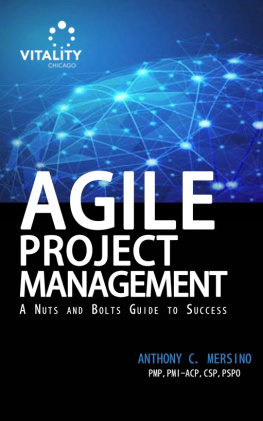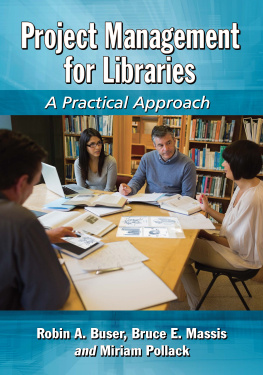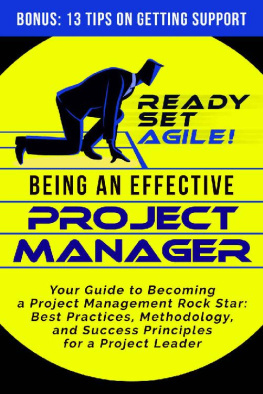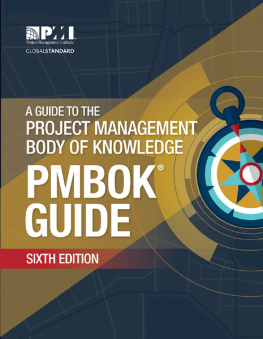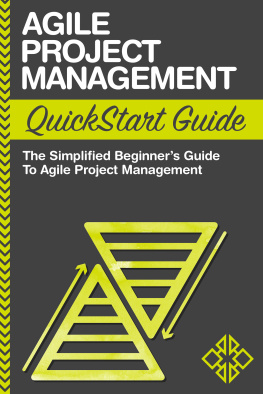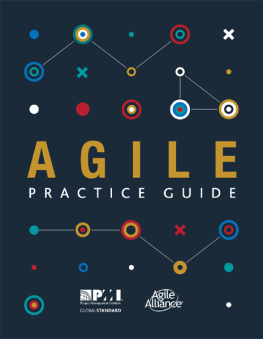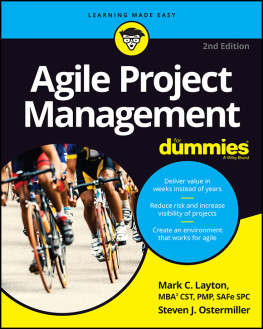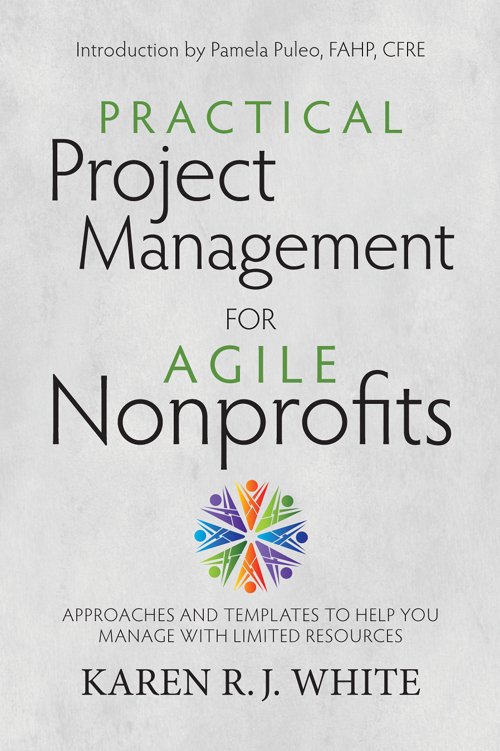PRACTICAL
Project
Management
FOR
AGILE
Nonprofits
PRACTICAL
Project
Management
FOR
AGILE
Nonprofits
APPROACHES AND TEMPLATES TO HELP YOU
MANAGE WITH LIMITED RESOURCES
KAREN R. J. WHITE
Introduction by Pamela Puleo

Published by Maven House Press, 316 W. Barnard St., West Chester, PA 19382; 610.883.7988; www.mavenhousepress.com.
Special discounts on bulk quantities of Maven House Press books are available to corporations, professional associations, and other organizations. For details contact the publisher.
Copyright 2013 by Karen R. J. White. All rights reserved. No part of this publication may be reproduced, stored in or introduced into a retrieval system, or transmitted in any form or by any means (electronic, mechanical, photocopying, recording, or otherwise) without either the prior permission of the publisher or authorization through payment of the appropriate per-copy fee to the Copyright Clearance Center, 222 Rosewood Drive, Danvers, MA 01923; 978.750.8400; fax 978.646.8600; or on the web at www.copyright.com.
While this publication is designed to provide accurate and authoritative information in regard to the subject matter covered, it is sold with the understanding that the publisher is not engaged in rendering legal, accounting, or other professional service. If legal advice or other expert assistance is required, the services of a competent professional person should be sought. From the Declaration of Principles jointly adopted by a Committee of the American Bar Association and a Committee of Publishers and Associations
Library of Congress Control Number: 2013934520
Paperback ISBN: 978-1-938548-00-0
ePUB ISBN: 978-1-938548-01-7
ePDF ISBN: 978-1-938548-04-8
Printed in the United States of America.
10 9 8 7 6 5 4 3 2 1
CONTENTS
LIST OF FIGURES
ACKNOWLEDGEMENTS
T his book would not have been completed without the support of Jim Pennypacker, a wonderful editor, publisher, and friend. His gentle encouragement, especially when writers block struck, was always appreciated!
I also want to acknowledge the numerous friends and associates who shared with me their experiences in supporting nonprofit organizations. It is their labors that initially encouraged me to write this book. In particular, I would like to thank Kerstin, Lori, Kelly, Jessica, Bethany, Pamela, John, and Ken; you never seemed to mind when I needed confirmation.
Finally, I would like to dedicate this book to all those volunteers and staff members out there supporting the nonprofit organizations that make our society so much better for all of us. Your efforts are indeed noticed by those you serve; I hope this book makes those efforts a bit easier to perform.
Karen R.J. White, MSc, PMP, PMI Fellow
Weare, New Hampshire
INTRODUCTION
Applied Agility
Practical Project Management for Agile Nonprofits
Pamela Puleo, FAHP, CFRE
Vice President for Community Affairs
Concord Hospital, New Hampshire
G one are the days when nonprofits were judged simply by their good works and the worthiness of their causes. Gone are the days when volunteers were plenty and fundraising was a community-based endeavor. Its a brave new world for nonprofits, a world where transparency, efficiency, and sound business practices must replace the benevolent approach, which characterized charitable operations of the past.
The expectations placed on todays nonprofit organizations continue to grow expectations for increased productivity amidst diminishing resources, expectations for expanded programming to meet community needs, and expectations from donors who want to be assured that their investments are sound. A nonprofits ability to meet demands, respond to expectations, and achieve goals may well depend upon its view of the future. Looking to the new possibilities along the horizon instead of focusing on the landscape in the rearview mirror may mean the difference between success and failure. And thats where Practical Project Management for Agile Nonprofits comes in. For the nonprofit to function and compete in the future, attention to applying project management practices and creating new mechanisms to attract and work with volunteers will be required.
The world of the nonprofit executive is a busy place. Rushing from one event to another, moving from campaign to campaign, and working to fill service and program gaps to meet constituents growing needs can leave the professional and his or her results fragmented. The reality that many nonprofits work through volunteers rare commodities today to achieve their goals makes it clear that its time to employ new skills to fulfill the vital and necessary missions of our third-sector organizations.
The concepts presented in this book have been proven effective in the for-profit sector, which applies various project management tactics daily to manage operations and achieve key business objectives. These same concepts, applied to the work of nonprofits, can help organizations become more organized, productive, and successful, utilizing resources to their utmost potential. For example, all fundraisers are project managers. Direct mail, special events, capital campaigns these are all projects unto themselves. The fundraisers ability to apply and utilize project management techniques will improve effectiveness and outcomes. Simply applying a consistent approach to a project using a work breakdown structure could alone yield tremendous benefit by organizing the work elements into small, manageable activities. The addition of project milestones assures that the initiative is moving along a stated timeline toward a successful conclusion. While busy professionals might argue that they cant afford the time it takes to create work breakdown structures for all of their key activities, in fact they cant afford not to. Not only does this approach ensure that all aspects of an initiative are well-planned for, it assures continuity of practice should a leader staff or volunteer step down from their role, a hazard faced all too often in the nonprofit world.
Virtually every nonprofit relies in some measure on a volunteer workforce to support its activities. From board members to envelope stuffers and everything in between, qualified and committed volunteers are often the nonprofits greatest assets. Yet relying on volunteers to shoulder the bulk of the organizations responsibilities in todays society could be a recipe for disaster. The volunteer landscape has changed dramatically over the past twenty-five years as traditional family roles have evolved and the millennium generation has come of age. The nonprofit that hasnt adjusted its approach to attracting and engaging a new crop of would-be volunteers may find that it doesnt have the human capital needed to fulfill its mission. Rather than longing for the good old days and bemoaning the loss, savvy nonprofits are adapting their organizations volunteer roles and the way they recruit for those roles to respond to a new generation of volunteer prospects. This new generation will seek out meaningful work on their own terms and expect the use of technology to drive communications and successful business practices to support their work. If nonprofits are fortunate enough to attract the attention of these new volunteers, organizations will need to remain attentive to meeting their expectations, motivations and unique needs.


